Issues relating to lawn damage from populations of these damaging grubs seem to be increasing and this article sets out to understand the environmental factors influencing this and what might be done to control the problems.
Lawn conditions that encourage or support grass eating grubs
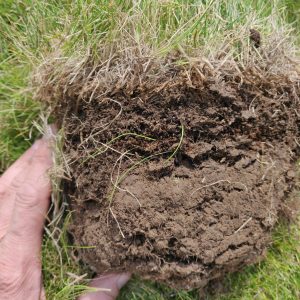
surface thatch in domestic lawn turf
Moss and Thatch: It is considered that mossy lawns or those lawns that are thatchy are more likely to suffer. For this reason, lawns should be regularly scarified, and property owners should be made aware of the risk and damage caused by grubs as a key reason for lawns to be scarified regularly to reduce the risk.
Water Retention: Lawns that sit wet over winter have been shown to suffer more with grass eating grubs than those that are drier. It is for this reason that we should take steps to improve soil structure, soil composition and draining. Aeration, at least annually, ideally twice per year, spring, and autumn should be introduced as part of the grass management programme. The application of compost-based top-dressing to improve soil structure and soil improver based on gypsum (to be launched).
Leatherjacket Management (crane fly larvae)
In the UK, several species of crane flies are commonly found in grasslands, including the following:
Tipula paludosa – This is one of the most common crane fly species in the UK and is often found in lawns and other moist habitats.
Tipula oleracea – This species is also commonly found in grasslands, as well as in fields, meadows, and other open habitats.
Tipula rufina – This species is known for its reddish-brown body and long, slender legs, and is commonly found in damp grasslands and other moist habitats.
Limonia nubeculosa – This species is also commonly found in grasslands, as well as in other habitats such as wetlands and riverbanks.
The life cycle of a crane fly typically involves four stages: egg, larva, pupa, and adult.
Egg: Female crane flies lay their eggs in soil, plant stems, or other moist habitats. The eggs hatch into larvae after a few days to several weeks, depending on the species and the environmental conditions.
Larva: Crane fly larvae, also known as leatherjackets, feed on plant roots and organic matter in the soil. They grow rapidly and moult several times as they mature. The larval stage can last from several months to several years, depending on the species and the environmental conditions.
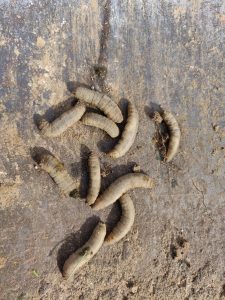
Crane fly larvae – leatherjackets
Pupa: When the larvae are fully grown, they pupate in the soil or in a cocoon. During the pupal stage, the larvae undergo metamorphosis and transform into the adult form.
Adult: The adult crane fly emerges from the pupal case and begins to mate and lay eggs. Adults have a short lifespan, typically only living for a few days to a few weeks, depending on the species. They feed on nectar and other liquids, but do not feed at all during their adult stage
‘The Effects of Soil Moisture and Nutrient Availability on the Life Cycle and Abundance of Tipula paludosa (Diptera: Tipulidae)’ by J.L. Craigen and J.E. Ball (1982) found that the life cycle and abundance of Tipula paludosa are influenced by soil moisture and nutrient availability. The study found that soil moisture had a greater impact on the life cycle of the crane fly than nutrient availability, with higher levels of soil moisture leading to faster development and higher populations of crane flies. The study concluded that changes in soil moisture levels could have a significant impact on the population dynamics of Tipula paludosa, and that managing soil moisture levels could be an effective way to control crane fly populations.
This is evidenced by our own observations of increased levels of winter lawn damage following excessive rainfall during the previous autumn.
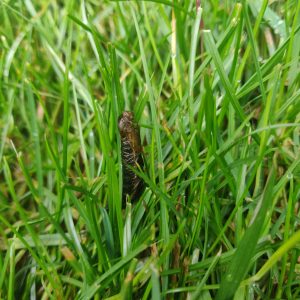
Leatherjacket larvae casing in lawn
Chafer Grub Management
There are four species of chafers regularly found in domestic UK gardens.
The Cockchafer (Melolontha melolontha): This species is thought to be responsible for the majority of lawn damage in UK gardens. It is also known as the “May bug” due to its habit of emerging from the soil in late spring. The Cockchafer grub is large, creamy-white in colour, and has a distinct, dark-brown head. It can cause significant damage to lawns
The Welsh Chafer (Hoplia philanthus): This species is smaller than the Cockchafer, with a lighter brown colour. The Welsh Chafer grub feeds on the roots of various plants, including grass
The Garden Chafer (Phyllopertha horticola): This species is similar in size to the Welsh Chafer and has a reddish-brown colour. The Garden Chafer grub feeds on the roots of plants, including shrubs and trees, and is considered a pest in gardens and orchards.
The Summer Chafer (Amphimallon solstitialis): This species is smaller than the Cockchafer and has a light-brown colour. The Summer Chafer grub feeds on plant roots and can cause damage to lawns and pastures.
Slight variation due to species or location and soil type but in general they emerge from the lawn between May and July to mate. The female chafers lay their eggs in the soil. The eggs hatch into larvae (grubs) within 2-3 weeks. The grubs feed on plant roots for several months, overwintering in the soil.
The grubs pupate in the soil in the late spring, and the adult chafers emerge to start the cycle again.
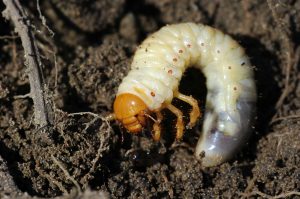
lawn grass root eating chafer grub
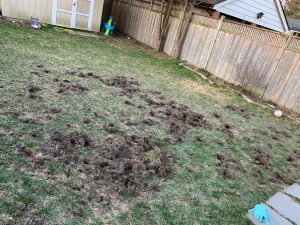
damage to lawn caused by grub eating birds
Biologic Control of Grass Eating Grubs
What are nematodes?
There are many of species of Nematodes, some beneficial to the gardener and others less so. Nematodes are tiny, worm-like parasites that can be used to control chafer grubs and leather jackets. They are applied to the soil in a solution, where they search out and infect the grubs. Once inside the grub, the nematodes reproduce and release toxins that kill the grub.
What influences the effectiveness of nematodes in treating lawn grubs?
The timing of the treatment is important, as nematodes are most effective when the grubs are actively feeding and close to the surface of the soil. It is also important to ensure that the soil conditions are suitable for the nematodes, as temperature, moisture levels and soil type can all impact results.
What else can influence the effectiveness of treatment?
Soil type and moisture: Nematodes need moist soil to survive and move through the soil to reach the grubs. The effectiveness of nematodes can be reduced if the soil is too dry or if the soil has a high clay content, as the nematodes may have difficulty penetrating the soil.
Temperature: The effectiveness of nematodes can also be influenced by temperature. The nematodes are most effective when the soil temperature is between 15°C and 25°C, as this is the optimal temperature range for the nematodes to move and reproduce. If the soil temperature is outside this range, the nematodes may still be beneficial, but that benefit may be reduced.
Pesticide use: The use of pesticides can have a negative impact on the nematodes and reduce their effectiveness. Pesticides can kill both the target pests (the chafer grubs) and the beneficial nematodes, so it is important to choose nematode treatments that are compatible with the pesticides you are using.
Application method: The method used to apply the nematodes can also influence their effectiveness. Nematodes are applied to the soil in a solution. The solution should be thoroughly watered into the soil to ensure that the nematodes are distributed evenly and reach the grubs. Soil should remain moist for 10 to 14 days after treatment.
Grub density: The density of grubs in the soil can also influence the effectiveness of nematode treatments. If the grub density is low, the nematodes may not be as effective, as there may not be enough grubs for the nematodes to find and infect.
Treatment Programme – Chafer Grub (assuming lawn does not need to be scarified)
Spring – aeration of lawn followed by application of nematodes and wetting agent
Application of high phosphorous and potassium fertiliser to aid root development/recovery
Autumn – repeat the above
Treatment Programme – Leather Jackets (assuming lawn does not need to be scarified)
Spring – aeration of lawn followed by DOUBLE DOSE application of nematodes and wetting agent
Application of high phosphorous and potassium fertiliser to aid root development/recovery
Autumn – repeat the above
Note that in some instances the lawn condition will not tolerate aeration due to lack of roots to anchor the turf. A full assessment must be carried out and if needed the aeration must be skipped.
Managing Expectations
There is no insecticide licenced for the control of grass eating grubs in the UK. Some lawncare companies are offering treatments of a product which is believed to be based on neem oil and is marketed as Turf Solve. This has not been tested nor is it licenced to be used for the control of grass eating grubs. As such they sell this service as a plant conditioner. In effect bending rules that are present for the protection of home owners and the environment. The UK Lawncare Association has investigated the claims of the distributor and found no evidence to support any claims that this is an effective treatment for these conditions. We also have no understanding of what other essential soil -living insects are being killed by this product.
We are reliant on biological controls. These are reliant on environmental condition to be effective. Specifically, soil temperature and moisture levels. As such we offer no guarantee that they will be successful in their purpose. However some action is considered to be better than no action and repeat action better still. Neither adult chafer or crane fly are strong flying insects and therefore populations seem to be localised with repeat issues, in the same areas, when environment conditions support a boost in population. Specifically wet autumns following drought summers where lawn grass has died back.
Following any action that we take it is essential that the homeowner or garden manager follows our specific after-care instructions thoroughly to increase the effectiveness of action.
Since the publication of this article we now have access to licenced insecticide for the control of leather jackets and chafer grubs. Read more here > Controlling Leather Jackets and Chafer Grubs in Lawns

 Established 2016
Established 2016



